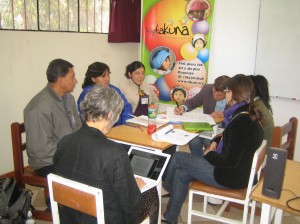Conference Brainstorming
Here in Huancayo, the people come together. Every Sunday morning, for example, there is always a huge gathering of the public at the central plaza for the izamiento (the patriotic raising of the flags – the national flag of Peru, the flag of Huancayo, and the flag of the representative institution of the week). Each flag is held in preparation by three different groups of people. It is beautiful to see these groups coming together in their respective uniforms – the national police, municipal government officials, and elementary/secondary school students. The event is always followed by the march of the national police accompanied by the army (who has their own band) and usually another parade by students.

It was, in fact, one of the primary themes that emerged from the workshop – the call for interdisciplinary teamwork. There was already a lot of good work going on and many pre-existing programs set up by different institutions for different needs, but the lack of unity between these institutions meant that a lot of babies-at-risk were lost in the transitional phases and there was often a complete absence of support for infants during their key years of development (from 0-3 years of age). Better interdisciplinary action also meant that mothers needed to be trusted and encouraged to be more involved. We witnessed an interesting dynamic enfold during the workshop as it became clear that the professor was dominating group discussions and often used academic or theoretical speak whereas we were looking for practicality and utility. The mothers later divulged that they felt out of place and uncomfortable asking questions or sharing their opinion.
We had our workshop moderator take more control over the professor’s comments while publicly encouraging the mothers to speak up. We were missing out on so much – the mothers had so much share. There were grave concerns regarding prenatal care; many mothers were preoccupied that they had irreversibly damaged their children’s development solely because they had fought with their husbands or had been crying too much during the months of pregnancy. The mothers also admitted that they continued with their traditional customs. For example, though medical professionals recommend against the customary practice, farming mothers in the sierra (living in the central Andes mountain range) still typically enfold their newborn babies tightly in layers of cloth so that they are immobile. The babies are enrolled this way daily in a certain position – upright with arms down and fingers splayed – before the mothers head out to the fields so that no damage is done from all the movement incurred while the mothers engage in physical labour, carrying their babies on their backs. This method also protects the infants from the harsh cold of the elevation and it is said that these babies also grow up physically stronger.
As we wrapped up the workshop, the participants came to the joint conclusion that there was a need to go back to the basics, to rediscover the value of the Peruvian and Huancaino culture. Just as we brought together people of various backgrounds, levels of education, and life experience for the purpose of the workshop, so too we realized that we needed to mesh the different types of knowledge uncovered – the known and the foreign, the theories and the practicalities, the science and the beliefs, the modern and the traditional. It seems that growth and positive change can occur when there is dialogue and humility.


